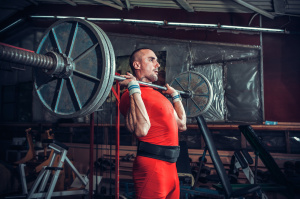 This is the final article that addresses the concept of an SRRR profile which stands for four factors that include: Stimulation (how you train), Recovery, Retention, and Readiness. The SRRR factor that will be discussed in this article is Readiness.
This is the final article that addresses the concept of an SRRR profile which stands for four factors that include: Stimulation (how you train), Recovery, Retention, and Readiness. The SRRR factor that will be discussed in this article is Readiness.
Readiness refers to a lifter being in a physiological state in which his or her body is ready to progress. There are two main factors to consider in regard to readiness. The first is that the joints, tendons, ligaments, and muscles must be ready to withstand a weight training stress while remaining healthy. If a lifter is placed in an unfamiliar position that their body is not ready for while using a heavy weight, injury can result. Lifts such as the dead lift, full squat, clean and jerk, and the snatch, all have the potential to devastate the back, the hips, and the knees of untrained lifters who have not taken the time to slowly work their way into the required lifting positions using light weights first. This holds true for any lift. When it is evident that a lifter’s body is handling a given lift without any negative side effects while using light weights, then weight can be systematically added over time.
The second aspect of readiness simply refers to a lifter’s body being in a state where it can be stimulated to make progress from workouts. It almost sounds like recovery but is not necessarily the same. It is possible that a lifter can recover his or her strength after a workout, but not be in a state where their body is ready to make any progress. In other words, they are stuck in what I refer to as a steady state where their strength has leveled off.
To further explain the need for readiness, we can look at the example of Bruce. For instance, Bruce may be recovering his strength after each workout, but finds he is stuck at the same strength level. Even if Bruce tries longer recovery times, he still doesn’t gain and may even lose strength. The reason is because Bruce keeps using shock training and his central nervous system is over taxed and has shut down his ability to gain. For those of you who are familiar with Precision Point Training concepts, Bruce has run into the Pattern That Kill Progress (please see the basics of PPT page on this website if you desire more explanation in regard to the Pattern That Kills Progress). Even though Bruce may be able to recover his strength within 72 hours after a workouts, he may need several weeks of easier training before his body is willing to gain again. He may even have to back off and lose a little strength in order for his nervous system to fully recover to the point where it will permit his body to become stronger.
If Bruce trains hard enough to cause an adaptation, but not so hard that he runs into the Pattern Than Kills progress, then his body is more likely to stay in a state of readiness where it ready to gain. The biggest culprits for destroying the body’s state of readiness consist of the following: a lifter who constantly trains above 90% of their one rep max, constantly training to failure and using forced reps, doing too many sets.
Training success is dependent on each of the four SRRR factors working properly. For example, if you focus too hard on stimulation (training), then recovery may suffer. If you focus too much on recovery by waiting longer between workouts, then detraining and loss of strength could occur. If you have poor retention, you will have to train more often which makes recovery more difficult. If readiness does not come easily for you, then training too hard will run you right into the Pattern That Kills Progress. A lifter who is superior in even one of the SRRR factors has an advantage, and a lifter who is superior in all four of the SRRR factors has it easy. They will be able to succeed with just about any type of training. Most people are not this fortunate.
One way to balance the SRRR factors is to use Precision Point Training. This means train hard enough to cause an adaptation, but no harder than necessary. This makes it easy to recover quickly and enables people with poor retention to train often enough to avoid detraining. Training that is not overly long or hard also keeps the central nervous system healthy so that the body can stay in a state of readiness where it is willing to adapt little by little to training stresses. Regardless of what form of training a lifter chooses, it has to be in agreement with their own SRRR profile if they are to succeed. This means if your training is working, keep doing what you’re doing. If not, think through the SRRR factors and which one(s) may need some correcting. Best of training to you.
